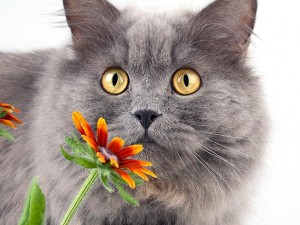If you are at all like me, this news is a breath of fresh air! I’m tired of hearing friends, family and co-workers proclaim “I could never come to your house. I would just die from cat allergies!” To which I always respond, “Not to worry, you weren’t invited!”
On the flip side, I have come across many people who absolutely love cats and cat allergies have prevented them from adopting one of their own. I’m thrilled that these people will soon have the opportunity to appreciate the great joy of cat companionship.
Now, I can only imagine, in a world without cat allergies – World Cat Domination is poised to happen sooner than we all expected!
Michael Harper for redOrbit.com – Your Universe Online
Good news for those allergic to cats: New research from the University of Cambridge has helped unlock some of the long-standing mysteries behind allergic reactions to cat dander. The British research team has discovered which biological toxin and receptors are responsible for triggering an extreme reaction to the combination of a cat’s skin flakes and saliva. It had been previously shown that a protein found in dander called Fel D 1 was seen as an invader of the immune system, but the new research identifies which part of the body reacts to this protein.
After conducting this research, the scientists now believe they can work towards delivering a drug to bring relief to those who experience reactions to dander from both cats and dogs. Researchers from the University of Nottingham had previously claimed they found a receptor in cells which kick stars an allergic reaction, though their findings are slightly different from those revealed this week by the University of Cambridge.
“We are hopeful that our research will lead to new and improved treatments for cat and possibly dog allergy sufferers,” said Dr. Clare Bryant, lead author of the research from the University of Cambridge’s Department of Veterinary Medicine, in a statement.
The Fel D 1 protein has often been hailed as the key component in cat dander that some react negatively to. The Cambridge researchers, however, have also found that a bacterial toxin called lipopolysaccharide (LPS) activates a receptor in the body known as the Toll-like receptor 4 (TLR4).
This receptor is also responsible for other allergic reactions, such as those from dust mites and metals.
To understand exactly how Fel D 1 and LPS react to TLR4 the team exposed human cells to these elements and observed the reactions. When LPS was present, the cells quickly began to trigger an allergic reaction, inflaming the skin when in the presence of Fel D 1.
Next the team used a drug that has been shown to block TLR4, thereby reducing its ability to react negatively when in the presence of normally allergy-inducing compounds. When the cells were exposed to Fel D 1 and LPS after being treated with the medication, there was no inflammatory response.
Dr. Bryant explains their conclusion this way:
“How cat dander causes such a severe allergic reaction in some people has long been a mystery. Not only did we find out that LPS exacerbates the immune response’s reaction to cat dander, we identified the part of immune system that recognizes it, the receptor TLR4.”
Taking their research one step further, the team employed the same TLR4 blocking technique in the presence of Can f 6, the protein found in dog dander that also induces an allergic response. The results from both tests were the same with the TLR4-inhibiting drug blocking a negative response when in the presence of dander.
In 2011, researchers from the University of Nottingham also claimed they had unlocked the mysteries of allergic reactions to dander. Their study pinpointed the source of a reaction to the mannose receptor (MR), a receptor found on the surface of dendritic cells. These cells are often the first to encounter allergens such as dander and the team deduced they could be responsible for triggering a response. They also found that MR is necessary for the body to react negatively to Fel D 1 as a foreign invader of the immune system and thereby start reacting negatively to it as a precaution.

